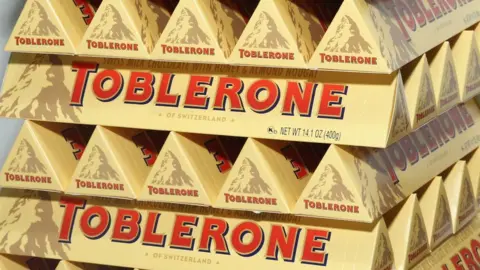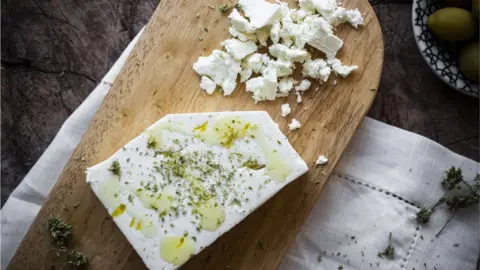Toblerone: Swiss rules mean chocolate bar to drop Matterhorn from packaging
 Getty Images
Getty ImagesToblerone is to remove the Matterhorn mountain peak from its packaging when some of the chocolate's production is moved from Switzerland to Slovakia.
The pyramid-shaped bar, which mirrors the Alpine peak, will undergo a labelling revamp and include its founder's signature, its maker said.
US firm Mondelez said the image of the 4,478m (14,692 ft) mountain will be replaced by a more generic summit.
Strict rules have applied about "Swissness" since 2017.
They state that national symbols are not allowed to be used to promote milk-based products that are not made exclusively in Switzerland. For other raw foodstuffs the threshold is at least 80%.
 Getty Images
Getty ImagesIn a statement to the BBC, Mondelez said it was moving some production outside of the country to "respond to increased demand worldwide and to grow our Toblerone brand for the future".
It said its new packaging would include a "distinctive new Toblerone typeface and logo that draw further inspiration from the Toblerone archives and the inclusion of our founder, Tobler's, signature".
Toblerone, the mountain-shaped chocolate made from Swiss milk with honey and almond nougat, first went on sale in 1908 in Bern, the capital city of Switzerland.
But it was not until 1970 that the Matterhorn's jagged silhouette debuted on its packaging, with the Bernese bear and eagle featuring before then, according to the Toblerone website.
Mondelez said Bern was an "important part of our history and will continue to be so for the future".
In 2016 Toblerone courted controversy by changing the design of the chocolate bar to space out the distinctive triangular chunks in a bid to keep down costs.
After much criticism the company reverted to the original shape two years later.

Other protected products
 Getty Images
Getty ImagesIn both the UK and EU, food and drink products can be granted speciality status based on where they are made, the method of composition or their ingredients. There's also evidence that being awarded this status can mean better prices for producers. Here are some examples:
Feta cheese
Only cheeses originating Greece that are soaked in brine and strained without pressure can be called Feta, the European Court of Justice has ruled. This is despite opposition from Germany and Denmark who produce a similar cheese. The Danes are still exporting their version under the name Feta to markets outside the EU.
Iberico Ham
Jamón Ibérico is also protected in the EU. The ham must come from Iberian blackfoot pigs that spend the last months of their lives eating acorns on the "dehesa", a Spanish or Portuguese pasture with old oak trees. It must also be hung and dry cured for at least 36 months.
But some US firms are now importing blackfoots to make their own ham which will be marketed as jamón ibérico armericano or Ibericus meat. They are allowed to because they are not beholden to EU law.
The US also makes its own champagne as it never ratified the 1919 Treaty of Versailles, under which the drink became a protected brand.
Darjeeling Tea
India's government forbids tea not made in Darjeeling from being labelled as such, and all producers must enter into a license agreement with the Tea Board of India. The tea can't be blended with teas of other origin and must be exported with certificates showing this. India's Tea Board went to the World Trade Organisation over what they called the unauthorised use and registration of 'Darjeeling' by Japanese companies in Japan.
Cambodian palm sugar
Despite opposition from some Belgian and Swiss firms, the EU officially recognised Cambodia's Kampong Speu palm sugar as a protected product. It's made from the sap of the palm sugar tree and is characterised by a rich aroma.
Dundee cake
The protected status of the fruit cake is currently under consideration. Proponents say it must always be decorated with whole almonds and has to be prepared, decorated and baked at locations within Dundee postcodes. But the application has led to objections from bakers outside Dundee including an Edinburgh baker who supplies the 300-year old London department store Fortnum and Mason.
